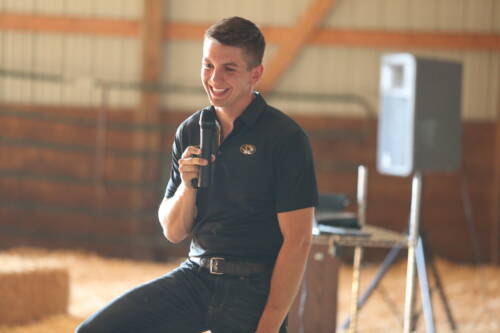This story also appears in our University of Missouri College of Agriculture, Food and Natural Resources’ Agricultural Research Center Magazine. Stop by your local Research Center to pick up a copy! You can view the magazine online by clicking here: Road to Discovery.
For years, the Thompson Research Center, near Spickard, Mo., has been home to a very defined breeding plan for its straight bred, commercial Angus cattle herd. That plan contains a variety of objectives, including reproductive and genetic goals.
With the strong success of that plan, a team from the University of Missouri Division of Animal Sciences is looking to expand and bring cattle breeding plans to several more MU College of Agriculture, Food and Natural Resources’ Agricultural Research Centers.
“At the Thompson Research Center, we have made it a focus to have a very defined breeding objective, and those objectives have been in place for years,” said Jared Decker, associate professor and state beef Extension specialist. “At Thompson, it’s all about producing white tablecloth beef. It’s about producing high quality beef while still paying attention to fertility.

“We’ve talked for years about implementing breeding plans and goals for the other Centers that have a beef presence. When Jordan (Thomas) got hired, he brought a lot of energy and passion to the team. He’s taken the lead on getting those objectives ready.”
Thomas, an assistant Extension professor, earned his undergraduate and master’s degrees from Mizzou, as well as his Ph.D. He has coordinated with six Research Centers and began conversations with stakeholders at each. Those Centers include: South Farm (Columbia), Horticulture and Agroforestry (New Franklin), Greenley (Novelty), Forage Systems (Linneus), Wurdack (Cook Station), and Southwest (Mt. Vernon). Thomas is using the Thompson Research Center breeding plan as a model.
“It’s not that every Research Center does the same thing – it’s more that each one is doing something meaningful,” Thomas said. “We want each of the Centers to reflect the best practices of reproduction and genomics. We want producers in each area, when they have a question, to go straight to our Research Centers. We want them to look at the breeding plan as a shining example of how to handle a cattle herd.”
Considering that all six Research Centers involved in working on updated breeding plans are spread throughout the state, Thomas has traveled to each one to gain an understanding of the systems at each Center. As each of the Centers deal with different climates, soils, cropping systems and ongoing research needs, it was important to see the herd in action.
“As we begin to think about making changes or go in a different direction, it’s vital to have stakeholder buy-in and support,” Decker said. “While we have a good feel for what can be successful, you never want to assume that you have all of the answers. It was important to us to make sure everyone was on the same page and for all of us to work as a team.”
According to Decker, the primary goal of implementing a breeding plan is to maximize profits and promote strong genetic traits.
“We’re trying to help producers make selection decisions and breeding decisions that help them maximize profitability,” Decker said. “As we’ve made best genetic selection decisions at Thompson, for example, we’ve been able to receive premiums in the marketplace. While we’ve received those premiums, we’ve also kept a focus on reproductive management. We want to keep those females that are going to be fertile and produce strong calves.”
 According to Jared Decker, the primary goal of implementing a breeding plan is to maximize profits and promote strong genetic traits.
According to Jared Decker, the primary goal of implementing a breeding plan is to maximize profits and promote strong genetic traits.Thomas and Decker have made major strides already at a couple of Centers, including the Southwest Research Center. A major focus at Southwest has been on management of cattle on the endophyte-infected fescue forage base that dominates Missouri. Thomas said the research needs of a Center play a major part in how the breeding plans have been developed.
“Research does dictate what we do, even if we would never manage a commercial herd for the same goal,” Thomas said. “Our goal isn’t to move away from research. We’re trying to grow the herd and make it the best herd possible, while actually expanding our abilities to do meaningful research.”
At Southwest, a reproductive focus is on evaluating management systems that involve use of sex-sorted semen to produce more heifer calves with elite genetics. That work is perfect for Thomas as a reproductive physiologist, and also aligns with Decker’s interest in genomic testing.
“There are so many possibilities at the Southwest Research Center as we grow the herd there,” Thomas said. “Red Angus is very progressive as a breed, and we’re working with them as they’re very focused on developing genetic predictions for maternal traits.”
Work at the other Centers is moving forward as well. A different approach is being taken at each site – but conversations with superintendents, advisory boards and regional industry professionals are a big key.
“As we’re formulating these ideas, we’re constantly getting feedback,” Thomas said. “We don’t want this to come across as us coming in from campus and making an executive decision. We want the plans and programs to be a team effort and really reflect the priorities of that region. We’re trying to tailor each plan to what the Center is focused on.”